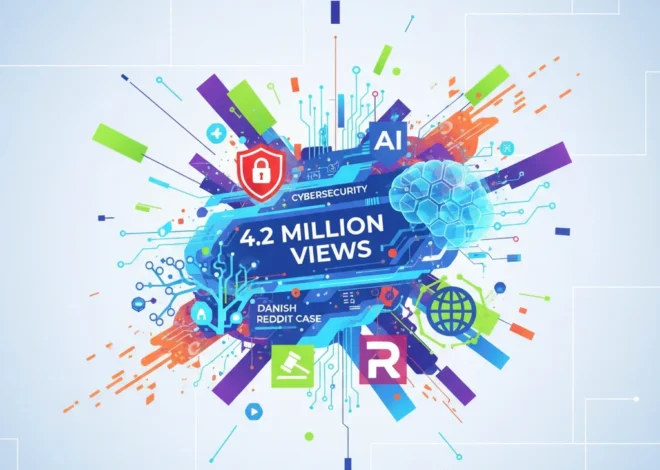
From Viral Fame to Digital Infamy: What a YouTuber’s Arrest Teaches Tech Leaders About AI, Cybersecurity, and Brand Implosion
The Unseen Code Behind a Public Downfall
In the hyper-connected world of digital media, news travels at the speed of light, amplified by algorithms and automation. Recently, influencer Jack Doherty, a YouTuber with a staggering 15 million subscribers, found himself on the wrong side of the law, arrested in Miami on drug possession charges. On the surface, this is just another headline in the tumultuous world of internet celebrity. But for developers, entrepreneurs, and tech professionals, this incident is more than just gossip—it’s a critical case study in the intersection of personal reputation, digital amplification, and the technological forces that can build or shatter a brand overnight.
The modern influencer isn’t just a personality; they are a startup. They are the CEO, CTO, and CMO of a media empire built on cloud platforms, powered by engagement algorithms, and monetized through sophisticated SaaS tools. When a “founder” like this has a public crisis, it reveals the vulnerabilities inherent in any tech-driven enterprise. This isn’t a story about one person’s alleged mistake. It’s a story about risk, reputation, and the powerful role that artificial intelligence, cybersecurity, and automation play in the 21st-century business landscape.
The Creator Economy: When an Influencer is a Startup
To understand the stakes, we must first reframe our perception of a content creator. An influencer with a multi-million subscriber base is not merely an entertainer; they are the founder of a high-growth startup. Their personal brand is the product, their content is the marketing, and their audience is the market. This “creator economy” is a behemoth, projected to nearly double in size to $480 billion by 2027, according to Goldman Sachs.
Consider the operational complexity:
- Product Development: Constant ideation, filming, and editing of content (the “software development” lifecycle of media).
- Infrastructure: Reliance on cloud-based platforms like YouTube, Instagram, and TikTok for distribution and scalability.
- Monetization: A diversified revenue stream from ad-share (SaaS-like recurring revenue), brand sponsorships, and merchandise.
- Analytics: Deep reliance on data analytics to understand audience behavior and optimize for engagement algorithms, a practical application of machine learning principles.
In this context, Jack Doherty’s arrest isn’t a personal issue; it’s a catastrophic business risk materializing. It’s akin to a SaaS company founder facing a major lawsuit that threatens investor confidence and user trust. The brand, meticulously built through thousands of hours of content and programming, is instantly jeopardized. For any startup, founder-related risk is a top concern for investors, and in the creator economy, the founder *is* the company.
Beyond the Hype: Is Elon Musk's Optimus Robot the Future of Everything?
The Algorithmic Firestorm: AI’s Role in Amplifying Crisis
When a crisis like this erupts, it’s the technology itself that fans the flames. The very systems that creators leverage for growth become instruments of their potential downfall. This is where artificial intelligence and automation enter the picture, not as abstract concepts, but as active agents in the narrative.
Social media and news aggregator algorithms are programmed for one primary goal: engagement. And nothing engages like controversy. Here’s how the tech stack of a modern scandal works:
- Signal Detection: AI-powered news bots and social listening tools instantly pick up on the initial reports. Keywords like “Jack Doherty,” “arrested,” and “Miami” trigger a cascade.
- Automated Amplification: The algorithms, recognizing a spike in engagement (likes, shares, comments), push the content to a wider audience. The story moves from a niche news alert to a global trending topic in minutes.
– Content Generation: AI-driven content farms may even begin to auto-generate low-quality articles, videos, and social media posts to capitalize on the trending search terms, further saturating the information ecosystem.
This automated firestorm leaves no room for a measured response. The speed and scale are beyond human capacity to manage manually. For any business, especially startups where brand reputation is a fragile, core asset, this presents a monumental challenge. Your company’s narrative can be hijacked and rewritten by machine learning models optimized for clicks, not for truth.
Cybersecurity and the Weaponization of a Public Persona
A public arrest also creates a significant cybersecurity vulnerability. The individual’s personal information, already public to some degree, becomes a focal point for malicious actors. This isn’t just about negative press; it’s about active digital threats.
In the wake of a scandal, a public figure becomes a prime target for:
- Phishing and Social Engineering: Attackers may impersonate journalists, lawyers, or law enforcement to trick the individual or their team into revealing sensitive information.
- Deepfakes and Disinformation: The existing controversy provides a fertile ground for creating AI-generated deepfake videos or audio clips to fabricate “evidence” or further damage their reputation. This is no longer science fiction; the software to do this is increasingly accessible.
- Doxing and Harassment: The heightened public interest can lead to the malicious publication of private information, creating real-world safety risks.
For a tech company or startup, the lesson is clear: a founder’s personal cybersecurity is integral to corporate cybersecurity. A compromised founder can lead to a compromised company, whether through leaked credentials, reputational blackmail, or social engineering that grants access to corporate systems. Innovation in cybersecurity must account for the human element, which is often the weakest link.
AI's Dirty Secret: Why Your Company's Biggest Hurdle Isn't the Algorithm
AI as the Shield: A New Paradigm for Reputation Management
While technology can fuel the fire, it also provides the most powerful tools for fighting it. The new frontier of public relations and brand management is being built on a foundation of artificial intelligence, machine learning, and cloud-based SaaS platforms. Startups and established companies alike are now turning to software to navigate these treacherous waters.
Below is a comparison of how traditional crisis management stacks up against a modern, AI-powered approach.
| Crisis Management Function | Traditional Approach (Manual) | AI-Powered Approach (Automated & Proactive) |
|---|---|---|
| Threat Detection | Relying on Google Alerts, manual social media checks, and press clippings. Slow and reactive. | Real-time sentiment analysis using machine learning models to detect negative trends before they go viral. Proactive and predictive. |
| Response Strategy | War-room meetings, brainstorming sessions, and manual drafting of press releases. Time-consuming. | AI-generated response templates, stakeholder mapping, and automated distribution across channels. Rapid and scalable. |
| Disinformation Fighting | Manually reporting fake accounts and false articles. Inefficient at scale. | AI algorithms that identify and flag coordinated inauthentic behavior (bot networks) and deepfakes for immediate takedown requests. |
| Impact Analysis | Post-crisis surveys and media value estimations. A lagging indicator of damage. | Cloud-based dashboards providing real-time analytics on brand sentiment, share of voice, and reputational score. |
This shift represents a massive opportunity for innovation. The demand for sophisticated SaaS solutions in “reputation security” is exploding. Developers and programmers who can build machine learning models that predict PR risks or design cloud architectures that can process global social media data in real-time are at the forefront of this new industry. According to one report, reputational damage is a top concern for executives, with major incidents costing companies millions (source). Software is the only scalable solution.
Actionable Lessons for Tech Leaders and Innovators
The Jack Doherty incident, when viewed through a technological lens, offers several critical takeaways for anyone in the tech space.
- Integrate Personal and Corporate Cybersecurity: Founders and key executives are high-value targets. Implement mandatory multi-factor authentication, regular phishing training, and a clear policy on social media conduct. Your personal digital hygiene directly impacts your company’s health.
- Invest in Proactive Brand Monitoring: Don’t wait for a crisis. Utilize AI-powered SaaS tools for sentiment analysis and social listening. Understanding the conversation around your brand is the first step to controlling it. This is a crucial part of the modern marketing and security stack.
- Build for Resilience: For developers and software architects, consider the “scandal” use-case. How does your application behave under the strain of a PR crisis? Can your cloud infrastructure handle a sudden, massive traffic spike driven by negative press? Is customer data properly segmented and secured to prevent a data breach during a time of organizational chaos?
- Embrace Ethical AI and Automation: As we build the next generation of AI tools, we must consider the ethical implications. Programming models for pure engagement can lead to the amplification of harmful content. The future of innovation lies in creating smarter, more context-aware AI that can differentiate between healthy debate and malicious disinformation.
More Than a Paycheck: Why Tesla's B Vote is a High-Stakes Bet on an AI-Powered Future
Ultimately, the digital world has collapsed the distance between a personal action and its global, technological consequence. A single event is ingested by a complex system of software, cloud infrastructure, and artificial intelligence, and the output can define the future of a brand. The leaders, developers, and entrepreneurs who understand this new reality—and prepare for it—are the ones who will build enduring enterprises in an age of digital volatility.


